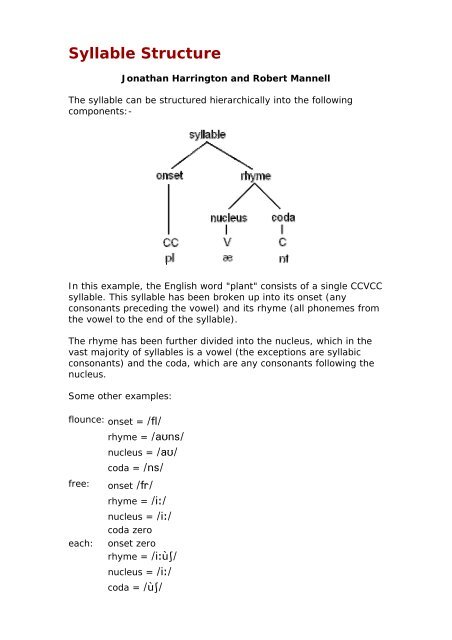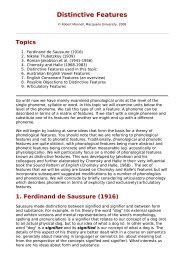The Syllable and the Foot : Summary - Speech Resource Pages
The Syllable and the Foot : Summary - Speech Resource Pages
The Syllable and the Foot : Summary - Speech Resource Pages
Create successful ePaper yourself
Turn your PDF publications into a flip-book with our unique Google optimized e-Paper software.
<strong>Syllable</strong> Structure<br />
Jonathan Harrington <strong>and</strong> Robert Mannell<br />
<strong>The</strong> syllable can be structured hierarchically into <strong>the</strong> following<br />
components:-<br />
In this example, <strong>the</strong> English word "plant" consists of a single CCVCC<br />
syllable. This syllable has been broken up into its onset (any<br />
consonants preceding <strong>the</strong> vowel) <strong>and</strong> its rhyme (all phonemes from<br />
<strong>the</strong> vowel to <strong>the</strong> end of <strong>the</strong> syllable).<br />
<strong>The</strong> rhyme has been fur<strong>the</strong>r divided into <strong>the</strong> nucleus, which in <strong>the</strong><br />
vast majority of syllables is a vowel (<strong>the</strong> exceptions are syllabic<br />
consonants) <strong>and</strong> <strong>the</strong> coda, which are any consonants following <strong>the</strong><br />
nucleus.<br />
Some o<strong>the</strong>r examples:<br />
flounce: onset = /fl/<br />
rhyme = /aʊns/<br />
nucleus = /aʊ/<br />
coda = /ns/<br />
free: onset /fr/<br />
rhyme = /iː/<br />
nucleus = /iː/<br />
coda zero<br />
each: onset zero<br />
rhyme = /iːùʃ/<br />
nucleus = /iː/<br />
coda = /ùʃ/
















